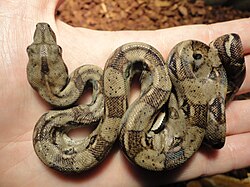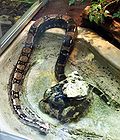Boa constrictor
Boa constrictor is a non-venomous Boa species.[2] The snake is found in Central and South America, and on some islands in the Caribbean. The common name is the same as the scientific name, which is unusual. The color pattern of its skin can vary considerably. Boa constrictors grow to a large size. There are ten subspecies.[3]
| Boa constrictor | |
|---|---|

| |
| Coiled | |
| Conservation status | |
| Scientific classification | |
| Kingdom: | |
| Class: | |
| Order: | |
| Suborder: | |
| Family: | |
| Genus: | |
| Species: | B. constructor
|
| Binomial name | |
| Boa constrictor Linnaeus, 1758
| |

| |
| Distribuition | |
Description
The size adult animals reach varies among subspecies. The largest animals have been found in Northern south America. Two animals from Suriname are currently the largest on record: One reached 411cm (13.5 ft), the other 427cm (a bit over 14 ft). Such sizes are rare, boas reaching 3m are considered large.[4] There is a report of a boa reaching 5.6m in Trinidad, but it is believed that snake was an anaconda,Eunectes murinus, taken for a boa.[5]
Boas can use their tail to grasp things. Boas do not have organs that react to warmth around the mouth.[6]
Boas have a color pattern that is brownish, and becomes brick red around the tail. Dorsally, the ground color is overlaid with a series of large tan-colored saddles that become lighter towards the tail. Here, the saddles break up into half rings of a pale cream color in vivid contrast with the red.[7]
Common names
All boids are constrictors, that is, they kill by squeezing their prey to suffocation. This species is a rare instance of an animal having the same common and scientific binomial name.
All subspecies are referred to as "boa constrictors". B. c. constrictor is also called the "common boa."[7]
Other common names include "jibóia" (Brazil) and "macajuel" (Trinidadian, pronounced mah-cah-well).[8]
Biology
Range
Found from northern Mexico through Central America (Belize, Guatemala, Honduras, El Salvador, Nicaragua, Costa Rica and Panama) to South America north of 35°S (Colombia, Ecuador, Peru, Venezuela, Guyana, Suriname, French Guiana, Brazil, Bolivia, Uruguay and Argentina. Also in the Lesser Antilles (Dominica and St. Lucia), on San Andrés, Providencia and many other islands along the coasts of Mexico and Central and South America.[2]
Habitat
Flourishes in a wide variety of environmental conditions, from tropical rainforests to arid country.[9]
Behavior
Small individuals may climb into trees and shrubs to forage, but they become mostly terrestrial as they become older and heavier.[4] It is said that specimens from Central America are more irascible, hissing loudly and striking repeatedly when disturbed, while those from South America tame down more readily.[9]
Feeding
Prey includes a wide variety of mammals and birds.[4] Their diet mostly consists of rodents, but larger lizards and mammals as big as ocelots are also reported to have been consumed.[9]
Reproduction
Ovoviviparous, females give birth to live young that average 15-20 inches (38–51 cm) in length.[4]
Captivity
This species does well in captivity, usually becoming quite tame. It is a common sight in zoos. Captive longevity is 20 to 30 years, with rare accounts of over 40 years, making them a long-term commitment as a pet. Proper animal husbandry is the most significant factor in captive lifespan. Though still exported from their native South America in significant numbers, it is widely bred in captivity.
Boa Constrictor Media
A captive boa constrictor strike-feeding on a large (already dead) rat
References
- ↑ Arzamendia, V.; Cisneros-Heredia, D.F.; Fitzgerald, L.; Flores-Villela, O.; Gagliardi, G.; Giraudo, A.; Ines Hladki, A.; Köhler, G.; Lee, J.; Nogueira, C. de C.; Ramírez Pinilla, M.; Renjifo, J.; Scrocchi, G.; Urbina, N.; Williams, J.; Wilson, L.D.; Murphy, J. (2021). "Boa constrictor ". IUCN Red List of Threatened Species. IUCN. 2021: e.T197462A2486405. doi:10.2305/IUCN.UK.2021-2.RLTS.T197462A2486405.en. Retrieved 27 March 2022.
- ↑ 2.0 2.1 McDiarmid R.W; Campbell J.A. & Touré T. 1999. Snake species of the world: a taxonomic and geographic reference. vol 1, Herpetologists League. ISBN 1-893777-00-6 (series). ISBN 1-893777-01-4 (volume)
- ↑ Boa constrictor (TSN 209569). Integrated Taxonomic Information System. Accessed on 11 July 2008 [[{{{year}}}]].
- ↑ 4.0 4.1 4.2 4.3 Mehrtens JM. 1987. Living Snakes of the World in Color. New York: Sterling Publishers. 480 pp. ISBN 0-8069-6460-X.
- ↑ Murphy J.C. & Henderson R.W. 1997. Tales of giant snakes: a natural history of anacondas and pythons. Malabar, Fl: Krieger Publishing. ISBN 0-89464-995-7.
- ↑ Parker H.W. & Grandison A.G.C. 1977. Snakes: a natural history. 2nd ed, British Museum (Natural History) and Cornell University Press. 108 pp. 16 plates. LCCCN 76-54625. ISBN 0-8014-1095-9 (cloth), ISBN 0-8014-9164-9 (paper).
- ↑ 7.0 7.1 Ditmars R.L. 1933. Reptiles of the World. MacMillan. 329 pp. 89 plates.
- ↑ Mendes J. 1986. Cote ce Cote la: Trinidad & Tobago Dictionary. Arima, Trinidad. p. 92.
- ↑ 9.0 9.1 9.2 Stidworthy J. 1974. Snakes of the World. Grosset & Dunlap Inc. 160 pp. ISBN 0-448-11856-4.
Other websites
| Wikimedia Commons has media related to Lua error in Module:Commons_link at line 62: attempt to index field 'wikibase' (a nil value).. |
| Wikispecies has information on: Boa constrictor. |
- Boa constrictor at the TIGR Reptile Database. Accessed 11 July 2008.
- Boa-constrictors.com. Accessed 11 July 2008.
- Red-Tail Boa Care at Herp and Green Iguana Information Collection. Accessed 11 July 2008.





